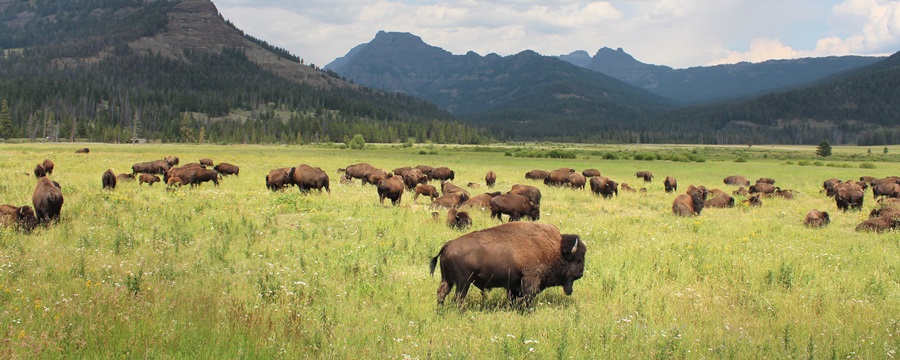On March 7, 2018, U.S. Secretary of the Interior Ryan Zinke joined U.S. Senators Lamar Alexander (R-TN) and Angus King (I-ME), Rep. Mike Simpson (R-ID), Rep. Kurt Schrader (D-OR) and others to introduce a bipartisan bill to rebuild America’s National Parks.
The proposed bill would use up to $18 billion in revenue derived from energy produced on federal lands and waters to establish a special fund within the Treasury specifically for “National Park Restoration”. [Note from Storm: As far as I can tell, this bill won’t increase the extraction of fossil fuels from federal lands, it only diverts some of the existing revenue into restoration, which would be a Good Thing. But I wouldn’t be surprised if a boost in production is buried in the text somewhere. If so, it would undermine a lot of these restoration measures by accelerating climate change, not to mention the immediate damage to federal lands caused by the extraction.]
The National Park Service estimates that its maintenance and repair backlog exceeds $11.6 billion. In 2017, 330 million people visited the 417 NPS sites across the country. The NPS completed over $650 million in maintenance and repair work in FY 2017, but aging facilities, high visitation, and resource constraints have kept the maintenance backlog between $11 billion and $12 billion since 2010.
Examples of renovation, restoration, and rehabilitation projects include:
- Everglades National Park (Florida) – Showers, campgrounds and lodges that were destroyed during a hurricane more than a decade ago remain broken. Total Everglades maintenance backlog cost, more than $90 million;
- Indiana Dunes National Lakeshore (Indiana) – Earlier this month, an observation deck overlooking Lake Michigan crumbled and fell to the ground after years of erosion. Total Indiana Dunes maintenance backlog cost, more than $26 million;
- Grand Canyon National Park (Arizona) – A pipeline, and the only infrastructure to deliver water to the South Rim Village of 19,634 people daily for drinking, cooking and firefighting, breaks several times a year putting the well-being of the community including park lodges, visitor centers, homes, and Grand Canyon hikers at risk. Total Grand Canyon maintenance backlog cost, more than $329 million; and,
- Statue of Liberty National Monument (NY/NJ) – $34.45 million is needed to stabilize the Ellis Island Seawall, which protects Ellis Island from erosion of wave action. $3.77 million is also needed to rehabilitate the Fire-Life-Safety System in the Main Immigration Building, where 2.2 million annual visitors start and end their visit to the island. Total Statue of Liberty National Monument maintenance backlog cost, more than $166 million.
The bill follows the blueprint laid out in the Trump administration’s budget proposal, the Public Lands Infrastructure Fund. The Alexander/King bill’s cosponsors are: Senators Shelley Moore Capito (R-WV), Martin Heinrich (D-NM), Steve Daines (R-MT), Cory Gardner (R-CO), and Thom Tillis (R-NC). This bill fulfills one of the priorities laid out in President Trump’s legislative framework for rebuilding America’s infrastructure.
“Infrastructure is an investment, not merely an expense. And every dollar we put in to rebuilding our parks, will help bolster the gateway communities that rely on park visitation for economic vitality. Since the early days of my confirmation, I’ve been talking with members of the House and Senate about how we can use energy revenue to rebuild and revitalize our parks and communities,” said Zinke.
“Infrastructure is also about access for all Americans. Not all visitors to our parks have the ability to hike with a 30-pound pack and camp in the wilderness miles away from utilities. In order for families with young kids, elderly grandparents, or persons with disabilities to enjoy the parks, we need to rebuild basic infrastructure like roads, trails, lodges, restrooms and visitors centers. This bill is the largest investment in National Parks in our nation’s history. This is not a republican or democrat issue, this is an American issue, and I think that the bipartisan body of lawmakers who put this bill forward is proof,” he continued.
While National Parks have enjoyed historic visitation over the past few years, many Americans have never been to a NPS site, and are unfamiliar with what infrastructure they contain.
Here’s a quick look at U.S. National Park Service infrastructure nationwide:
- More than 5,500 miles of paved roads;
- More than 1,700 bridges and tunnels;
- More than 17,000 miles of trails;
- More than 1,300 campgrounds;
- More than 24,000 buildings including more than 500 visitor centers, 425 park lodges and hotel buildings, 3,870 housing units and more than 3,700 bathrooms;
- More than 1,000 miles of water pipelines;
- More than 1,500 water systems;
- More than 1,800 wastewater systems;
- More than 500 electrical systems.
“Montanans are blessed to have America’s most beautiful national parks right outside our front doors,” said Senator Daines. “These critical economic drivers must be maintained and protected so that our outdoor economy can continue to grow and our parks remain accessible to all Montanans. This bipartisan bill is a commonsense step forward to ensure that the challenges facing our national parks are finally addressed.”
Featured photo of Yellowstone National Park via Adobe Stock.

